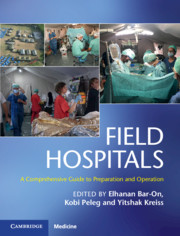Book contents
- Field Hospitals
- Field Hospitals
- Copyright page
- Contents
- Contributors
- Preface
- Section 1 History
- Section 2 Scenarios
- Section 3 Operational Considerations
- Section 4 Clinical Considerations
- Section 5 Additional Contextual Considerations
- Chapter 29 Forensic Medicine and Victim Identification in the Field Hospital Setting
- Chapter 30 Prehospital Care in the Disaster Setting
- Chapter 31 Long-term Deployment and Continuity of Care
- Chapter 32 Ethical Dilemmas in Field Hospital Deployments
- Chapter 33 Legal Issues in Field Hospital Deployments
- Index
- Plate Section (PDF Only)
- References
Chapter 31 - Long-term Deployment and Continuity of Care
from Section 5 - Additional Contextual Considerations
Published online by Cambridge University Press: 09 January 2020
- Field Hospitals
- Field Hospitals
- Copyright page
- Contents
- Contributors
- Preface
- Section 1 History
- Section 2 Scenarios
- Section 3 Operational Considerations
- Section 4 Clinical Considerations
- Section 5 Additional Contextual Considerations
- Chapter 29 Forensic Medicine and Victim Identification in the Field Hospital Setting
- Chapter 30 Prehospital Care in the Disaster Setting
- Chapter 31 Long-term Deployment and Continuity of Care
- Chapter 32 Ethical Dilemmas in Field Hospital Deployments
- Chapter 33 Legal Issues in Field Hospital Deployments
- Index
- Plate Section (PDF Only)
- References
Summary
The world’s most fragile states contain 38% of the world’s population and are among the world’s poorest. In these states up to 10% of all deaths and 20% of deaths among young adults may be attributed to untreated surgical disease, and over 500 000 women die each year during childbirth. International aid organizations have a presence in fragile states notably the International Committee of the Red Cross (ICRC). The potential for long-term field missions to address disparities in access to acute trauma, surgical, and obstetric care is not to be underestimated. Every opportunity for training and support of local health care staff is to be valued. The success of long-term deployments rests on sound planning before the implementation of programs and honest appraisal of ongoing programs.
- Type
- Chapter
- Information
- Field HospitalsA Comprehensive Guide to Preparation and Operation, pp. 297 - 303Publisher: Cambridge University PressPrint publication year: 2020



